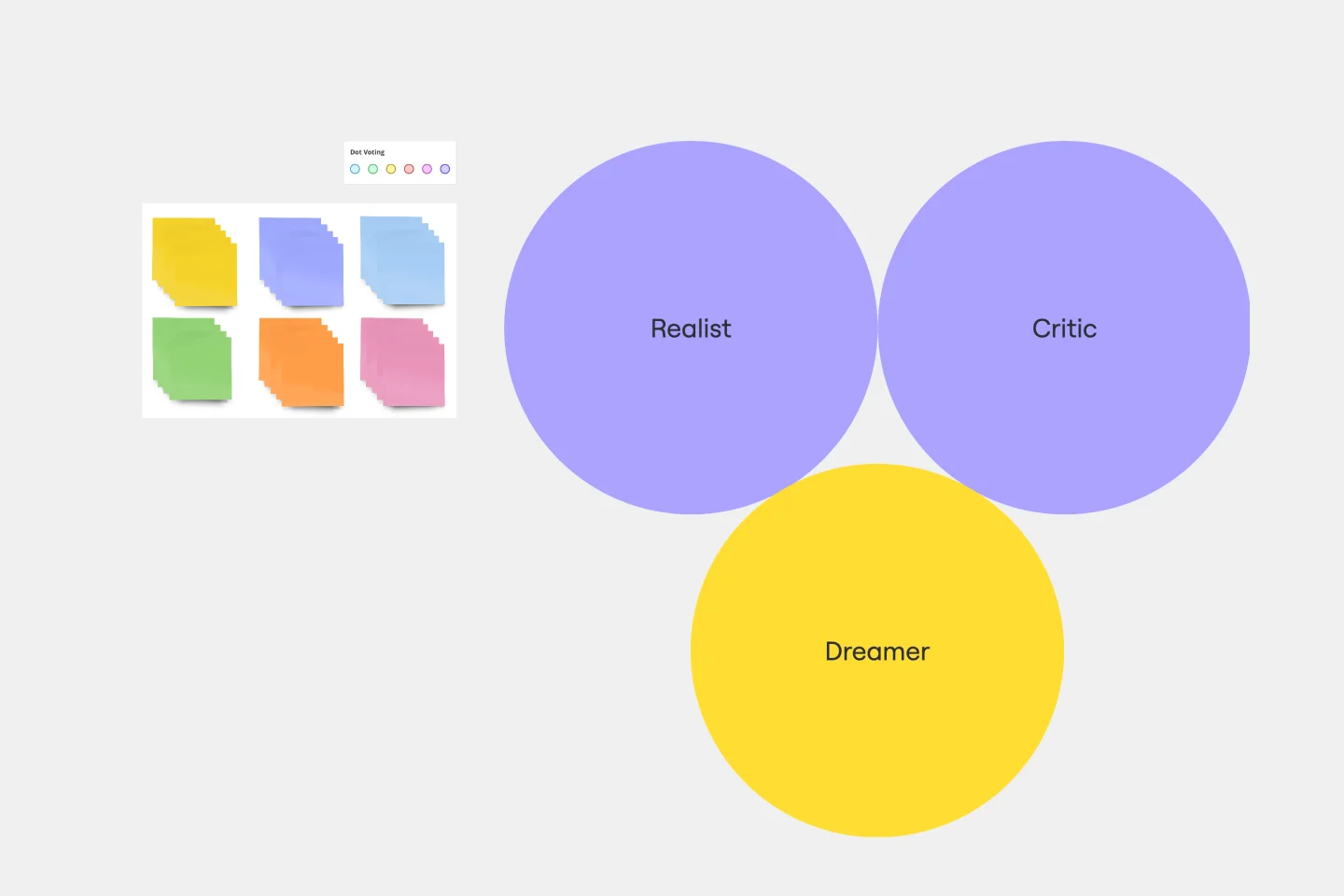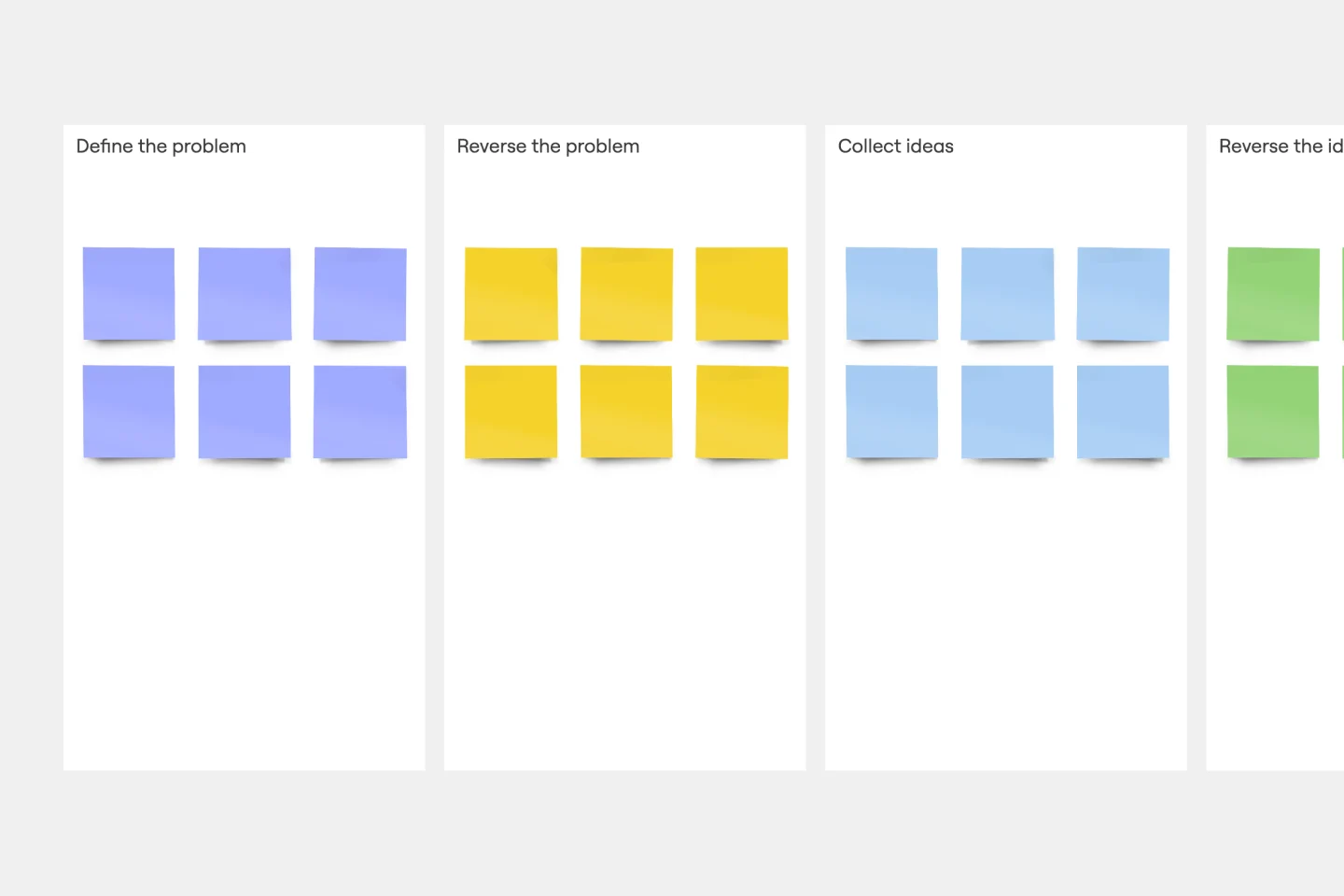About the Six Thinking Hats Template
Individuals and groups use the Six Thinking Hats technique to separate conflicting modes of thinking. They enable and encourage a group of people to think constructively together in exploring and implementing change, rather than using arguments to fight over who is right and who is wrong.
What is the Six Thinking Hats Template?
This Six Thinking Hats Template is designed to help a team evaluate and develop an idea further. It will help create space for creativity and help you make better-informed decisions by using the six different modes of thinking represented in six different hats: blue hat (organising the thinking), yellow hat (value), grey hat (risk), red hat (feelings), green hat (creativity), and white hat (information).
How to use the Six Thinking Hats template
The Hats are used to give direction to the thinking. They are a signal for everyone in the team to use the same mode of thinking at the same time. They are not for categorizing thoughts after they have been had.
The person organizing the meeting uses the Blue Hat to set out a sequence of Hats that sets the agenda for the meeting. This template uses a preset sequence for evaluating and developing ideas:
Blue Hat: The Conductor's Hat (at the beginning of the sequence). Thinking about and managing the thinking process. The blue hat is the control hat. In the beginning, the blue hat sets the agenda, focus, and sequence of hats.
White Hat: The Factual Hat. The white hat is all about information. What information do you have, what information you need and where to get it.
Red Hat: The Hat For The Heart. The red hat is about gut reactions, feelings, intuitions, and instincts at a particular point in time. The red hat invites feelings without justification. This is important because feelings can change over time.
Yellow Hat: The Value Hat. The yellow hat is for a positive view of things. It looks for the benefits and values.
Grey Hat: The Judge's Hat. The grey hat identifies risk. It is used for critical judgment and must give logical reasons for concerns. It is one of the most powerful hats.
Green Hat: The Creative Hat. The green hat is for creative thinking and generating new ideas, alternatives, possibilities, and new concepts.
Blue Hat: The Conductor's Hat (at the end of the sequence). The blue hat at the end of the sequence is for summaries, conclusions, decisions, and plans for action.
Here are some important things to note:
The hats can be used on your own or in a group.
In group discussions, it is essential that everyone uses the same hat (mode of thinking) at the same time. This is to avoid personal preferences and conflicts between modes of thinking.
Training in the use of the hats includes how to structure the hats into sequences to address different situations. This provides a structure and direction for thinking, leading to more productive and enjoyable discussions.
The history behind the Six Thinking Hats
The Six Thinking Hats were created by Dr. Edward de Bono and have been adopted in training programs by organizations around the world since 1991. The de Bono network includes accredited trainers and facilitators in 72 countries through 18 training partners who act as Authorised Distributors. We provide in-person and virtual training and facilitation, supported by interactive digital courses and applications, to help you apply the methods to topics that are important to you. Please contact us https://www.debono.com/authorised-distributors. This summary was reproduced with permission from de Bono.
The Six Thinking Hats is a registered trademark. Copyright Edward de Bono Ltd 2021.
FAQ about the Six Thinking Hats Template
What do the six thinking hats mean?
Each of the six hats represents a way of thinking: the blue hat is about organising the thinking, the green hat is for creativity, the red hat is for feelings, the gray hat is risk assessment, the yellow hat looks for value, and the white hat is for facts.
What are the benefits of six thinking hats?
The Six Thinking Hats is an excellent tool for you and your team to use empathy, intuition, creativity, and analytical thinking in complementary ways when making decisions. It enables you and your team to think from different perspectives, and it’s a great method to reach an agreement without having arguments.

Miro
Your virtual workspace for innovation
Miro is an innovation workspace designed for teams of every size, everywhere, to dream, design, and build the future together. Our mission? To empower these teams to create the next big thing, powered by AI at every step of the way. Over 90 million users around the world rely on Miro to untangle complex ideas, put customer needs first, and deliver products and services faster. All supported by best-in-class security, compliance, and scalability.
Categories
Similar templates
Brainwriting Template

Brainwriting Template
Brainstorming is such a big part of ideation. But not everyone does their best work out loud and on the spot, yelling out thoughts and building on others’ ideas. Brainwriting is a brilliant solution for them—creative thinkers who happen to be more introverted. This approach and template invites participants to reflect quietly and write out their ideas, and then pass them to someone else who will read the idea and add to it. So you’ll get creative ideas from everyone—not just the loudest few.
Disney Creative Strategy Template

Disney Creative Strategy Template
Know who knew a little something about coming up with ideas that set imaginations alight? Walt Disney. And he inspired the Disney Creative Strategy, an approach that establishes three types of thinkers—dreamers, realists, and critics—and gives each the space to do clear thinking. Your team will go through an engaging exercise of adopting the three mindsets, where they’ll focus on a specific aspect of the idea. The Disney Creative Strategy has a way of yielding brilliant ideas and great products. That’s why it’s used successfully by organizations of all kinds and sizes.
Reverse Brainstorming Template

Reverse Brainstorming Template
Reverse brainstorming is a technique that prompts a group to think of problems, rather than solutions. Because we naturally think of problems, it’s a great way to get a group to anticipate problems that may occur during a project. To engage in reverse brainstorming, start by identifying the problem, and then think of things that might exacerbate it. Ask your team to generate ideas around ways in which the problem could get worse. Reverse the problems into solutions again, and then evaluate your ideas.
Brainwriting Template

Brainwriting Template
Brainstorming is such a big part of ideation. But not everyone does their best work out loud and on the spot, yelling out thoughts and building on others’ ideas. Brainwriting is a brilliant solution for them—creative thinkers who happen to be more introverted. This approach and template invites participants to reflect quietly and write out their ideas, and then pass them to someone else who will read the idea and add to it. So you’ll get creative ideas from everyone—not just the loudest few.
Disney Creative Strategy Template

Disney Creative Strategy Template
Know who knew a little something about coming up with ideas that set imaginations alight? Walt Disney. And he inspired the Disney Creative Strategy, an approach that establishes three types of thinkers—dreamers, realists, and critics—and gives each the space to do clear thinking. Your team will go through an engaging exercise of adopting the three mindsets, where they’ll focus on a specific aspect of the idea. The Disney Creative Strategy has a way of yielding brilliant ideas and great products. That’s why it’s used successfully by organizations of all kinds and sizes.
Reverse Brainstorming Template

Reverse Brainstorming Template
Reverse brainstorming is a technique that prompts a group to think of problems, rather than solutions. Because we naturally think of problems, it’s a great way to get a group to anticipate problems that may occur during a project. To engage in reverse brainstorming, start by identifying the problem, and then think of things that might exacerbate it. Ask your team to generate ideas around ways in which the problem could get worse. Reverse the problems into solutions again, and then evaluate your ideas.